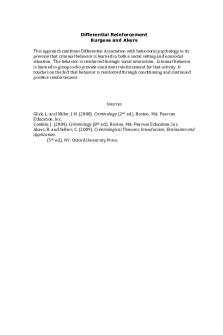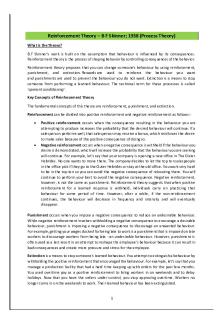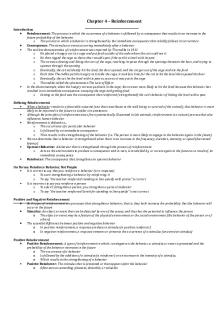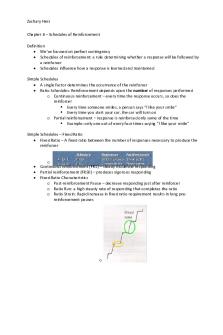Differential reinforcement PDF

| Title | Differential reinforcement |
|---|---|
| Course | Applied Behavior Analysis |
| Institution | California State University Sacramento |
| Pages | 4 |
| File Size | 88.7 KB |
| File Type | |
| Total Downloads | 112 |
| Total Views | 152 |
Summary
Notes on differential reinforcement. Class taught by Katie Lee Carothers....
Description
Name Differential Reinforcement Types of differential Reinforcement
Extinction combines with reinforcement - EXT problem behavior - REINFORCE alternative or appropriate behavior Different types: 1. Differential reinforcement of alternative behavior (DRA) 2. Differential reinforcement of other behavior (DRO) 3. Differential reinforcement of low rates of responding (DRL)
DRA – Differential Reinforcement of Alternative Behavior
When to use DRA
1. You want to increase a desirable behavior and/or decrease undesirable behaviors 2. The desirable behavior already occurs at least occasionally (or you can prompt it) 3. You have a reinforce you can use.
Using DRA
1. Define the target behavior to increase and the undesirable competing behaviors to decrease 2. Identify the reinforce for the problem behavior 3. Choose a reinforce for the desirable behavior – how? “Reading the chapter”(Preference assessment. 4. Reinforce desirable behavior immediately and consistently – why? - Prompt the desirable behavior if necessary Prompt before undesirable behavior occurs, not after Prompt when EO and Sd are present - Desirable behavior should require < response effort than problem behavior - Greater magnitude of reinforcement for desirable bx. 5. Eliminate (or minimize) the reinforce for the undesirable behavior 6. Use intermittent reinforcement for maintenance – why?
Considerations in the Use of DRA
Reinforcer is delivered for desirable behavior Extinction for the problem behavior E.g., negative statements about co-workers Variations of DRA: - DRI = Differential reinforcement of incompatible behavior E.g., to reduce knuckle cracking, reinforce hand squeezing (cant do both at the same time) - FCT = Functional communication training or differential reinforcement of communication To reduce head banging to access attention, reinforce the use of an ASL sign
Consider manipulating establishing operations to make the reinforcer more potent Consider the use of rules or instructions Fade artificial reinforcers to natural reinforcers to help maintain the behavior.
Differential Negative Reinforcement of Alternative Behavior (DNRA)
DRO – Differential Negative Reinforcement of Other Behavior
Examples of DRO
1. 2. 3. 4. 5. 6. 7. 8.
Desirable behavior produces escape or avoidance of aversive stimulus Undesirable behavior no longer produces escape/avoidance Ex: Johnny screams and wipes all materials off his desk during math -> teacher sends him to the “quiet area” of class (to not disrupt his peers) - With DNRA, usually these type of kids are the one who want to be in the time out area. Also called differential reinforcement of zero responding or zero rate of behavior Reinfrocer is delivered for the absence of the problem behavior for a specific period of time - Intervals are chosen based on the baseline level of the problem behavior - Extinction for the occurrence of the problem behavior - If the problem behavior occurs, the interval is reset good to use when goal is to eliminate behavior entirely.
Attention delivered every 30 seconds every 30 seconds without SIB Breaks from academic tasks delivered every 20 minutes for the absence of problem behaviors Access to favorite toy given each ½ hour for the absence of fighting with siblings If child has no tantrum for the first minute of dinner, gets a reinforce (praise) then for every further minute that there is no tantrum
Whole Interval DRO – The problem must be absent for the whole interval for reinforcement (referred to simply as DRO) Momentary DRO – the problem must be absent at the end of the interval for reinforcement - Why would researchers investigate this type? Which type of DRO is preferred? Why?
Identify the reinforce for the problem behavior Identify the reinforce to use in DRO Choose the DRO interval Use extinction for the problem behavior (or minimize the reinforcement for the problem) Deliver the reinforce for the absence of the problem behavior in each interval The occurrence of the problem behavior resets the interval for the delivery of the reinforce Gradually increase the DRO interval Use instructions when applicable.
Used to get a behavior to occur less (not necessarily to eliminate the behavior)
-
Example: Used with smoking (i.e., smoke less than 20 per day -> Sr+ -> then less than 18 per day -> Sr+) - Example: Used with kid in a classroom asking too many questions Two types of DRL - Full session DRL - Spaced responding DRL
Full session DRL
The reinforce is delivered when fewer than a specified number of responses occurs per time period (session) The reinforcer is delivered at the end of the session The timing of responses in the session is not important Ex: Ordering drinks at the bar. Having to wait in line.
Spacing Responding DRL
The reinforce is delivered for a response when it is separated from the previous response by a specified interval of time If a response occurs before the end of the interval, the interval is reset Individual responses are reinforced when the inter-response time (IRT) is greater than X The timing of responses is important Ex: only raising your hand once every 10 minutes, or only having 5 drinks an hour.. Timing matters.
Full session DRL - Reward given for smoking fewer than 5 cigarettes per day - Child given computer access in class only if he raised his hand fewer than 3 times during math period - Dessert given if teenager checks her cell phone fewer than 2 times during dinner.
Reward given to smoker only if it has been 3 hours since his last cigarette Child called on to answer in class only if it has been 25 minutes since he last raised his hand Person with intellectual disability who eats too fast allowed to take a bite of food only if 15 sec. since last bite of food.
Full session DRL
Spaced responding DRL
Implementing DRL Comparing DRO and Spaced responding DRL
Is DRL the appropriate procedure? - Do you want to decrease but not necessarily eliminate the behavior? Determine the acceptable level of the behavior Decide on full session DRL or spaced responding DRL Inform the client of the criterion for reinforcement Use a procedure to give the client feedback on number of responses or timing of responses Use intermediate goals if necessary DRO – at the end of the interval, the reinforce is delivered for the absence of the behavior DRL – at the end of the interval, the reinforce is delivered for the
Summary
first response In DRO and DRL, a response before the end of the interval resets the interval.
Use this space to write a two or three sentence summary of what you just read....
Similar Free PDFs

Differential reinforcement
- 4 Pages

Differential Reinforcement
- 1 Pages

Reinforcement-Theory
- 2 Pages

Differential Diagnosis
- 4 Pages

Differential Equation
- 2 Pages

Conjugate Reinforcement Paradigm
- 4 Pages

Reinforcement+versus+punishment
- 2 Pages

Connective Tissue Reinforcement
- 1 Pages

Differential Scanning
- 8 Pages
Popular Institutions
- Tinajero National High School - Annex
- Politeknik Caltex Riau
- Yokohama City University
- SGT University
- University of Al-Qadisiyah
- Divine Word College of Vigan
- Techniek College Rotterdam
- Universidade de Santiago
- Universiti Teknologi MARA Cawangan Johor Kampus Pasir Gudang
- Poltekkes Kemenkes Yogyakarta
- Baguio City National High School
- Colegio san marcos
- preparatoria uno
- Centro de Bachillerato Tecnológico Industrial y de Servicios No. 107
- Dalian Maritime University
- Quang Trung Secondary School
- Colegio Tecnológico en Informática
- Corporación Regional de Educación Superior
- Grupo CEDVA
- Dar Al Uloom University
- Centro de Estudios Preuniversitarios de la Universidad Nacional de Ingeniería
- 上智大学
- Aakash International School, Nuna Majara
- San Felipe Neri Catholic School
- Kang Chiao International School - New Taipei City
- Misamis Occidental National High School
- Institución Educativa Escuela Normal Juan Ladrilleros
- Kolehiyo ng Pantukan
- Batanes State College
- Instituto Continental
- Sekolah Menengah Kejuruan Kesehatan Kaltara (Tarakan)
- Colegio de La Inmaculada Concepcion - Cebu






